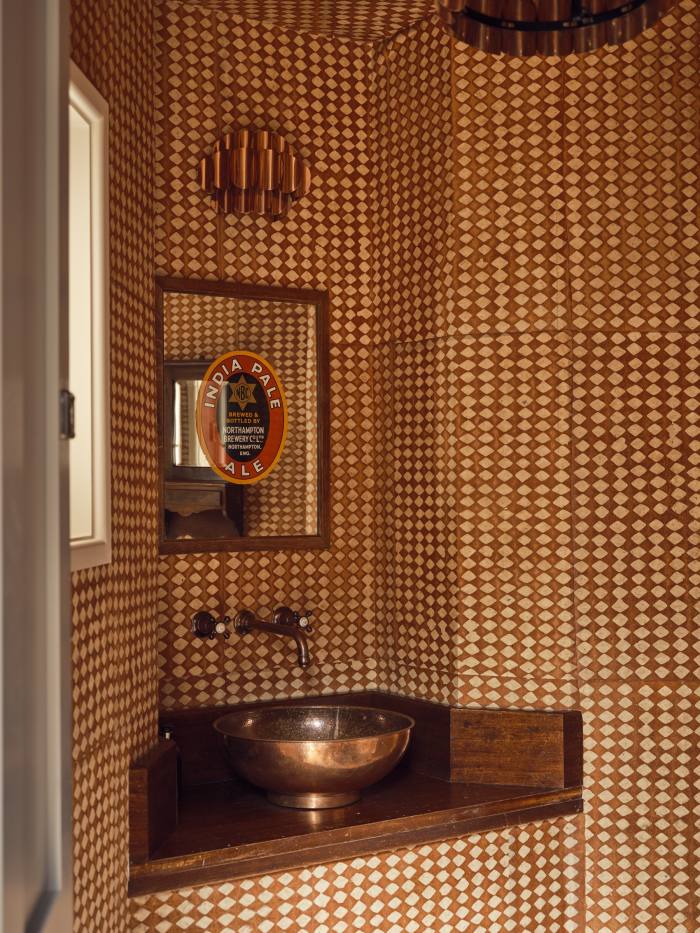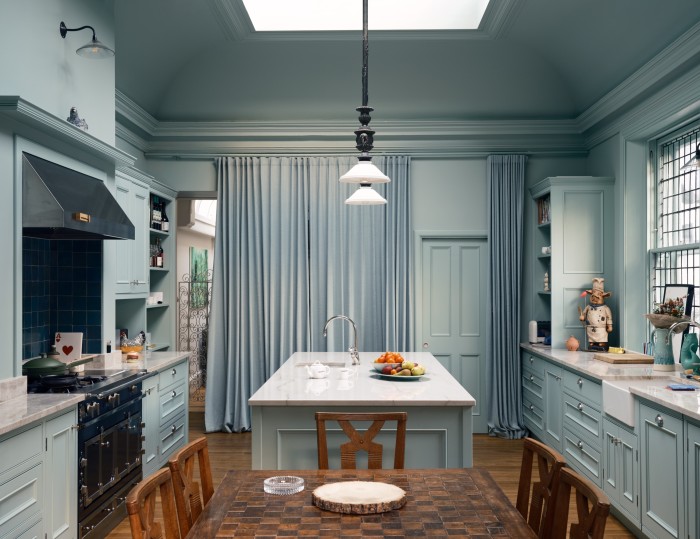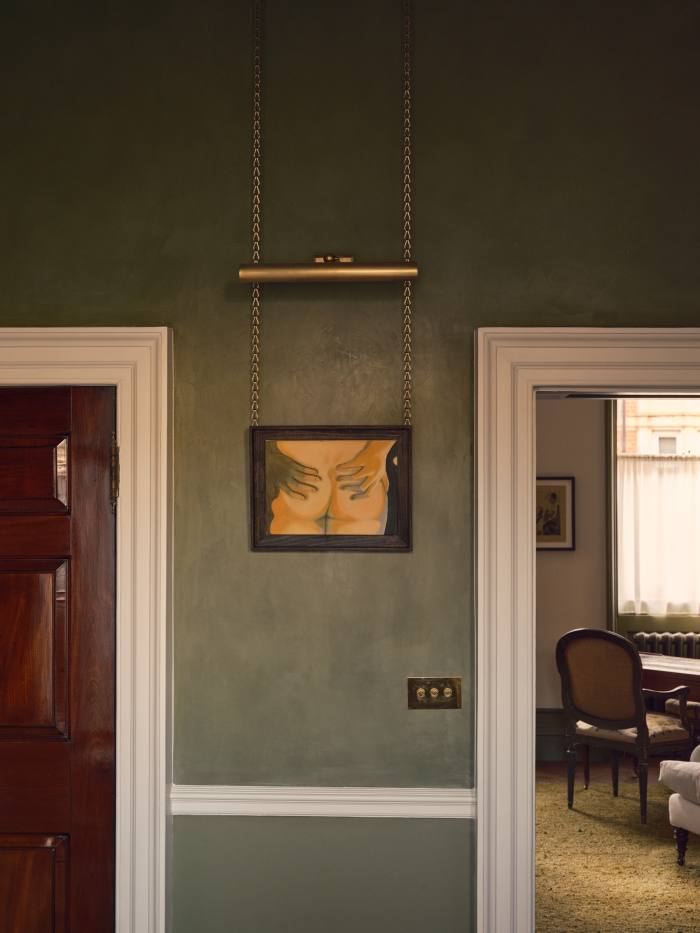Curator, artist and collector India Rose James has been hailed London’s “Princess of Soho” by the media. The pink-haired 31-year-old is the granddaughter of Soho Estates founder Paul Raymond who, along with her half-sister Fawn, became the main beneficiary of the pornography publisher and property magnate’s £1bn-plus estate when he died in 2008: the portfolio included the freeholds of Soho House and the former Foyles bookstore. Aged just 16, James was handed a £329mn fortune and unparalleled freedoms. Today her rebellious years are behind her, and now she prefers to hang out at home with her six-year-old daughter Sapphire (“Saffi” or “the Saffinator”, as she calls her), the daughter of her ex-partner, The Kooks guitarist Hugh Harris, than to be on the social scene.
I find her alone at her new London home on a January morning – not amid the neon haze of Soho but on a quiet street behind the façade of a grand terrace, an area that still conveys the sense of Georgian gentility that once lured London’s high society before this part of town was colonised by private surgeries. James moved into a former doctor’s office last summer, having waited six years for the four-storey building to be renovated. “It was done sensitively – we enhanced the natural features of the house,” she says, citing numerous setbacks including preserving a protected London plane tree, now happily shading the rear garden.


James calls it her “forever home” – the manifestation of a new phase of life in which, following five years of sobriety, she is establishing herself not only as a property magnate in the footsteps of her grandfather but as a serious player in the art world. The house is within walking distance of the family’s Soho Estate’s Ilona Rose House redevelopment, the historic former Foyles site now transformed into 80,000sq ft of office space with 10,000sq ft of landscaped terraces. It is also home to the estate’s headquarters and James’s Soho Revue Gallery, which, established in 2015, promotes emerging artists. James has converted a separate building of the site into artists’ studios, which open this month.
Her gallery, having moved for a time to Walker’s Court – once the site of the Raymond Revuebar, and now housing The Box, Madame Jojo’s nightclub and a theatre, alongside shops – has returned to its original location at 14 Greek Street. The original frontage, painted peppermint green, remains intact but leads into a new exhibition space. It opened last October with the inaugural show Artificial Paradises by the artist Caroline Wong. This month it is hosting shows by both Lorena Lohr and Bianca MacCall. It’s all very accessible, with works starting at £200 to attract younger collectors. “I want to bring the buzz of art back to the West End,” she said of her mission at the opening of the space.


An array of upcoming artists have also taken over James’s home – their work creating colourful interludes from one room to the next. In the entrance hallway, I gaze at Juliette, by Ella Walker, an artist with a feminist take on medieval frescoes, which James sourced from New York-based gallery Casey Kaplan. “I haven’t quite finished the art curation yet; it’s something I’m doing slowly,” she explains. “I leave them out and get a feel for where they should go. I might have to buy smaller pieces from now on to fit them all in.” Fresh-faced, her candy-floss-coloured hair tied neatly in a ponytail and her small frame swamped in a long, grey jumper, she is joined by two boisterous Brussels Griffon pups, who bound in from the kitchen and slide across the flagstones, coming to a halt at her feet. “They’re my fur babies – they follow me everywhere,” she laughs, as she picks Lilith from the floor. Smaug looks on enviously.

The space around us is a snapshot of everyday life: coats belonging to various family members are piled on a rack by the door (James’s father John stays over frequently and has seconded the basement cinema room as his own), and a guitar case (seemingly belonging to her boyfriend, the American musician Daniel Vildósola) is discarded on an ornate rug by the fireplace. A large, ceramic tiger stands guard at the foot of the staircase leading to the upper floors. “I have a thing for animals. I also have a stuffed peacock upstairs and a French ceramic pig in the kitchen that is the same as one I had growing up – he broke so my sister found another for my birthday. If I’d done better in science, I would probably have been a zookeeper,” she says, patting the tiger’s head. “I found Barry on Vinterior. He’s been repaired with Japanese Kintsugi [golden joinery]. My grandfather had a small, ceramic tiger in his flat and every time we went in I’d stroke it. Hopefully, Saffi will have the same sense of nostalgia about this one.”
She continues on into the adjoining sitting room, “the red room”, a Rothko-inspired jolt to the senses in which the sweep of the artist’s brush is expressed as textural tadelakt plaster walls. “I also saw a very similar red in the Prado Museum in Madrid. Each of the rooms has a colour theme, but very loosely,” explains James.


The interiors were all conceived alongside Maria Speake of the north-west London design studio and salvage business Retrouvius, which she co-founded with her husband, Adam Hills, in 1993. “A friend of mine who is really into fashion and design said I had to work with Maria,” says James of commissioning the designer, who describes herself as a “house helper” and is known for interiors layered with patina, texture and complexity conveyed through rescued objects and materials. “She got that I wanted the decor to be quite trad, because of the original features, but personalised. I wanted us to choose every piece together.”
The studio itself provided endless inspiration. Retrouvius is an Aladdin’s cave filled with reclaimed objects, many presented as innovative design solutions – metal panels as wall cladding or architrave as staircase treads – so that clients can envisage how they would look and feel in real life (part of Speake’s house, the space is furnished to convey how salvaged materials can be used in a contemporary way). It was here that James was struck by the earthy warmth emanating from the clay walls. “She spent most of the time on this huge sofa we had out in the studio, which she wasn’t aware of at the time but had been The Vampire’s Wife’s Susie Cave’s,” says Speake. “That went into the sitting room in newly reupholstered linen.”



A trove of kilims and textiles conjuring images of sun-scorched desert cities and flying carpets also informed the decor; fabrics such as an early 1900s Turkish rug from carpet specialist Joshua Lumley and a bespoke ottoman made from an old kilim add texture to James’s home. “We spend most of the time in this sitting room,” James says of the ensemble. “Saffi plays her video games here.”
James decided to use traditional chain fixings to hang her artworks so as not to damage the tadelakt walls. And the works add pops of colour and interest throughout the house. In the red room, the female form is realised in acrylic and ink in Nell Nicholas’s The Island of Aphrodite, while upstairs in the formal green sitting room, Yulia Iosilzon’s The Pond, a swirl of verdant oils on panels of transparent fabric, draws the eye.

As we find our way into the green room, the scent of palo santo lingers (“My friend came to cleanse the house and gave me a tarot reading this morning,” says James, not entirely earnestly). We admire The Pond under a gigantic Murano pendant light that once adorned Rome’s Palazzo Montecitorio. It is just one of the sexy retro flourishes that elevate the room. James points to a series of objects placed neatly on an equally fabulous glass-topped coffee table – a piece from London dealer Schmid McDonagh. What appears to be an ashtray filled with discarded cigarette butts is Alma Berrow’s In the big smoke artwork; it is placed insouciantly atop a Tracey Emin book (the artist’s Dark Cross painting hangs in the bathroom). “There’s also one of my grandfather’s porn storybooks. My friends don’t really know him,” she says of her grandfather, a colourful impresario who brought one of the first striptease clubs to London. “But older people still ask about him,” she smiles.


The adjoining library-music room is painted white with green detailing and contains yet more revelations. “I’m a big backgammon player,” James admits, lifting the lid of a midcentury c1950 rosewood Italian table, revealing a backgammon board. “It’s quite fun to whip out at a party,” she laughs. “I love how social it is because you can entertain while playing a game. Saffi’s a chess player and that’s different – you have to be all in.”
The artworks around us include a piece by her friend Antonia Showering entitled The Survivors. “I definitely want to support her practice but I have to like the art,” she says of whether she feels pressure to buy the work of friends. “If I’m not going to put it in my house, there is no point in buying it. I don’t agree with buying for investment,” she says of her curation. Atop the polished sideboard are stacks of old vinyls: “Most were my birth mum’s [Debbie Raymond] or ones collected over the years.”


Colour and comfort coalesce in each of the bedrooms. James’s green bedroom (“it’s my favourite colour”) is vivified by a Verdure tapestry that frames the bed, and heavy, hand-dyed velvet curtains that remind James of a theatre stage. We take a peek in her closet. She slips on a pair of sky-high velvet Saint Laurent sandals. “These are my favourite shoes. They’re the classic Biancas. But I don’t go out that much any more so I wear them here,” she laughs. “I never want to get rid of anything so Saffi can inherit it. She’s already sneaking in here – you know because you hear the clonking!” The only painting in the bedroom is a portrait of Saffi by James’s own hand.
The last space – her formal dining room – has been taken over by art. Canvases are stacked along the walls and pieces laid out on the table ready to be hung. She hovers over them, tracing the corners with her finger. Perhaps one of the artists here will be the next to “bring the buzz back” to Soho, a bohemia transformed into a more polished version than the one her grandfather knew. James represents a very different kind of cultural voice in central London than her grandfather’s. Paul Raymond’s Soho is all but gone, but I think that he’d approve.
Stay connected with us on social media platform for instant update click here to join our Twitter, & Facebook
We are now on Telegram. Click here to join our channel (@TechiUpdate) and stay updated with the latest Technology headlines.
For all the latest Art-Culture News Click Here
